
Indicolite Gemstone: Properties, Meanings, Value & More
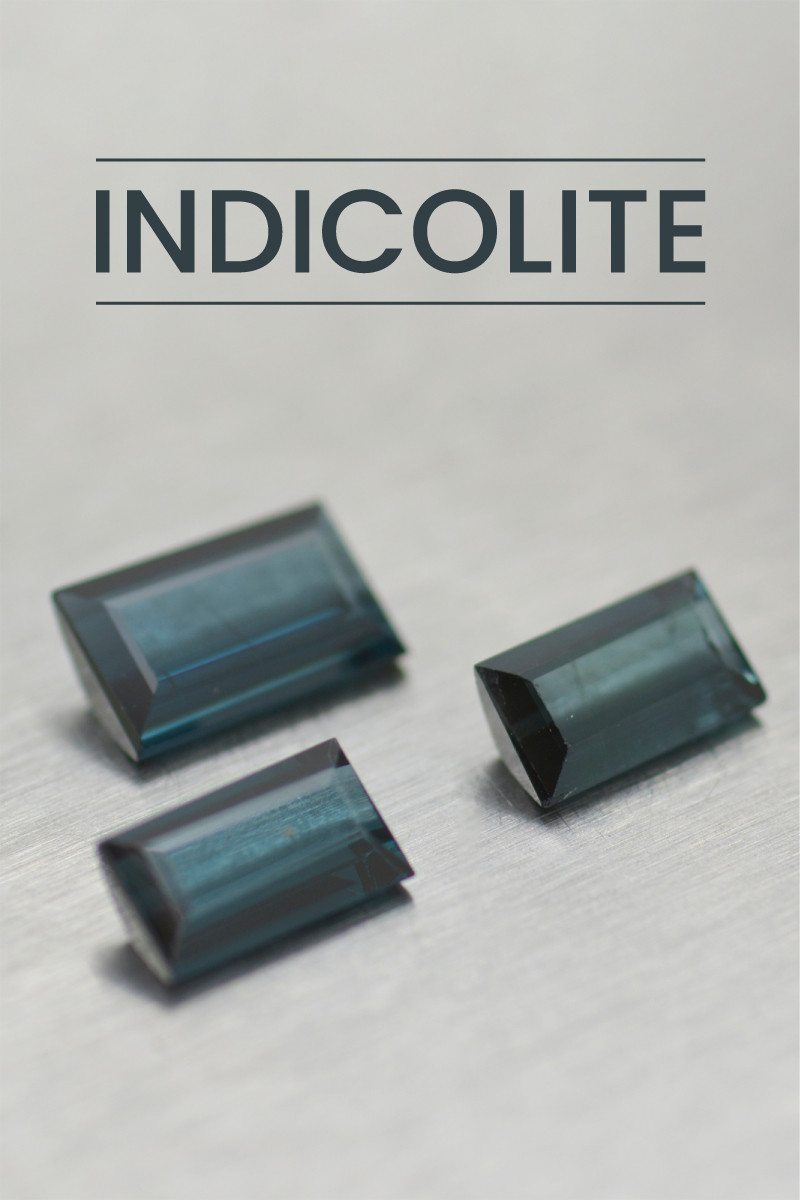 Indicolite (pronunciation: in-duh-KOH-lite) is a mineral in the complex tourmaline family of gemstones. But is indicolite a gemstone itself? Yes! Indicolite is found as gemstones in various shapes and jewelry.
Indicolite (pronunciation: in-duh-KOH-lite) is a mineral in the complex tourmaline family of gemstones. But is indicolite a gemstone itself? Yes! Indicolite is found as gemstones in various shapes and jewelry.
The tourmaline family is complex and expansive. Some are known for having specific colors, like the brown to black schorl series containing black tourmaline.
What is indicolite’s color? This tourmaline’s color comes in shades of blue, sometimes with green undertones.
So, is blue tourmaline the same as indicolite? Generally, yes. Indicolite is often dubbed “blue tourmaline.”
Tourmaline is the most colorful mineral, but is indicolite a rare color? Yes, blue is actually the rarest color of tourmaline.
Ready to explore indicolite in depth before browsing indicolite tourmaline for sale? Join us as we go over indicolite gemstone properties, prices, meanings, and grading.

About Indicolite Stone
Indicolite tourmaline is a semi-precious gemstone, though Brazilian indicolite is sometimes sold as “Brazilian sapphire,” for its similar appearance to the precious gem. However, sapphires are separate stones and labeling tourmalines as sapphires is against FTC guidelines.
That said, indicolite’s resemblance to sapphire makes it a more affordable alternative to the traditional September birthstone and 40th wedding anniversary gem.
As a tourmaline, indicolite is a traditional October birthstone, 8th wedding anniversary gem, and Libra zodiac stone. Indicolite also benefits Taurus, Leo, and Scorpio, along with being a star stone for Mercury and Pluto.
Additionally, tourmaline is the official state mineral of Maine, USA. Other monikers for the stone include “indigolite” and “aqualite.”
Ever heard of aesthetics like cottagecore or dark academia? “Indicolite” is another one named after the crystal, an elegant aesthetic encompassing vintage blues, sparkles, and water elements.
Speaking of elements, let’s get into the elements inside indicolite’s composition and the stone’s mineral traits.

Indicolite Specifications & Characteristics
The tourmaline family is complex, with several varieties under the umbrellas of a few overarching series, similar to garnet. Even indicolite’s formula is complicated: Na(Li,Al)1.5Al6(Si6O18)(BO3)3(OH)3(OH).
Indicolite is a complex borosilicate in the elbaite tourmaline series (or species). Elbaite is the most common gem-quality series and contains aluminum, sodium, and lithium. Besides indicolite, other popular elbaite gems are verdelite, watermelon tourmaline, and often rubellite.
Other important tourmaline series are schorl and dravite.
Usually, indicolite crystals are prismatic. Tourmaline crystals are known for having defined striations (long grooves on the surface) going vertically down the longer faces. Also along these long faces, or through cross-sections, tourmalines like indicolite often show color-zoning.
Tourmalines are also unique in sometimes forming as 3-sided prisms or being hemimorphic, meaning the crystal’s tip and base have different shapes.
Below are the remaining indicolite mineral properties:
Mohs hardness: 7-7.5
Color: Shades of blue, greenish-blue, or blue-green
Crystal structure: Trigonal
Luster: Vitreous (glassy)
Transparency: Transparent to opaque
Refractive index: 1.62-1.64
Density: 2.90-3.10
Cleavage: Poor/indistinct on [1120] and [1011]
Fracture: Conchoidal
Streak: White
Luminescence: Fluorescence sometimes present but weak - bluish-green in SW-UV & LW-UV
Pleochroism: Present & strong in dark to light blue
Birefringence: 0.014-0.022
Dispersion: 0.017 (moderate)
Optical effects: Possible chatoyancy
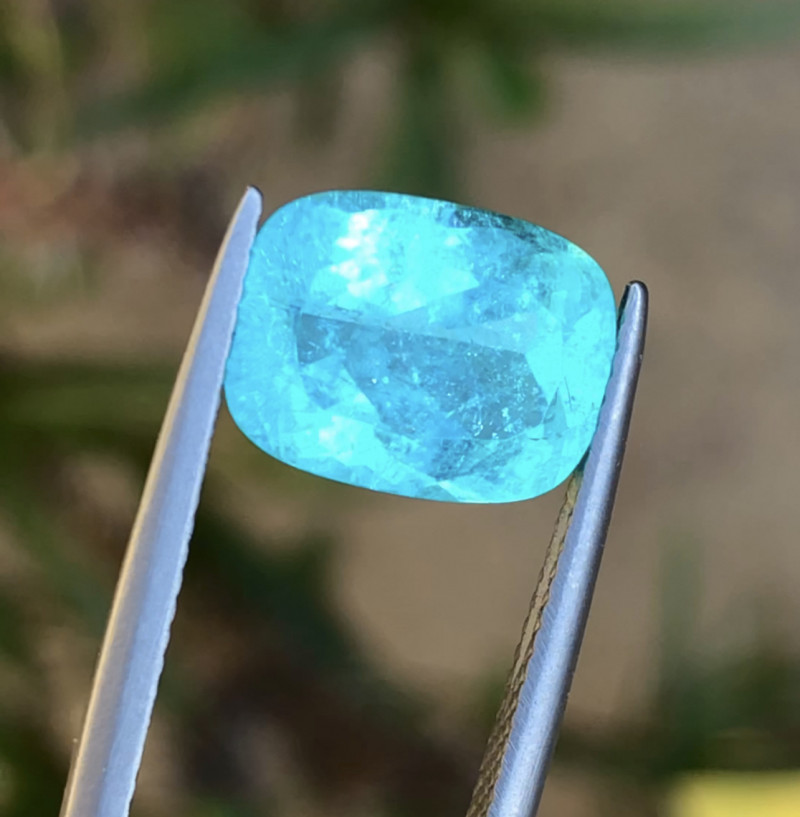 Pictured above: Paraiba tourmaline
Pictured above: Paraiba tourmaline
Indicolite vs. Paraíba Tourmaline
Another stone in the elbaite series we didn’t mention above is Paraíba tourmaline, or “cuprian elbaite.” Paraíba tourmaline is an intensely saturated neon-blue, blue-green, or violet tourmaline named for its discovery in Paraiba, Brazil, in the 1980s.
Despite its locale-based name, Paraiba is technically defined by its copper content. Therefore, non-Brazilian locales have since found and mined Paraiba tourmalines. The most valuable Paraiba tourmalines have electric blue or violet coloring.
What’s the difference between indicolite and Paraiba tourmaline?
For one, Paraiba is known for more vibrant, saturated colors and goes beyond blue and green into violet shades. The cause of Paraiba’s color is copper (with manganese added in violet shades), while indicolite’s color comes from iron.
Second is rarity. Though all blue tourmaline is rare, Paraiba is the rarest tourmaline variety of all. This is reflected in its price, as premium gems can be 6-times the price of premium indicolite gems of similar size.
With that important difference cleared up, we’ll dig into indicolite’s symbolism throughout time next!
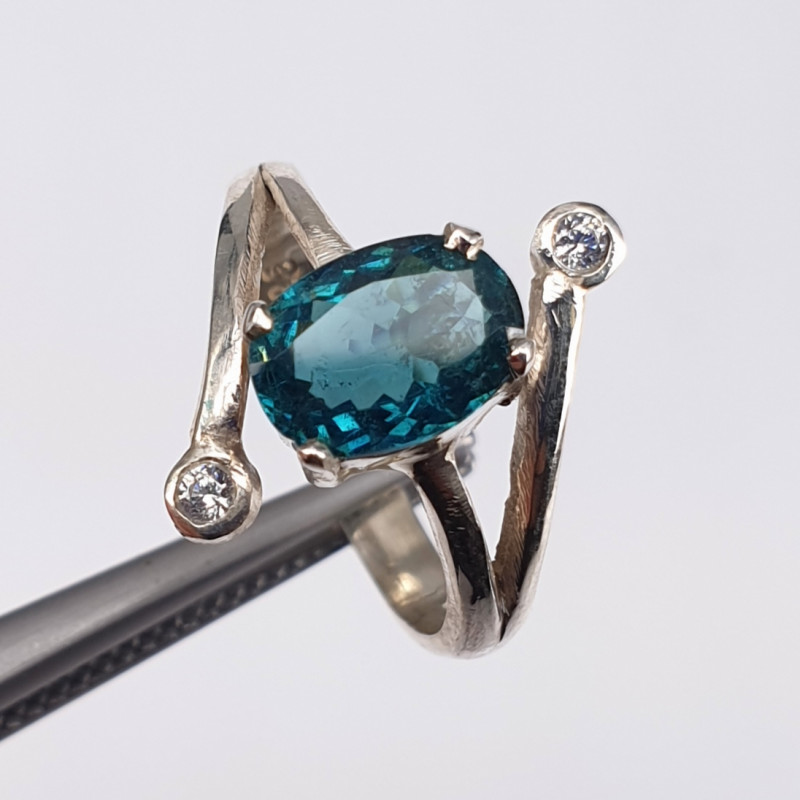
Indicolite Meaning & History
Indicolite symbolizes inspiration, open-mindedness, and empathy.
Throughout history, folks have associated plenty of folklore with tourmalines. Ancient Egyptian legends claim tourmaline’s rainbow of colors came from the stone traveling from Earth’s center, then along a rainbow, absorbing its spectrum.
In more modern times, indicolite has been adopted as a lucky talisman by various groups. It’s also believed to enhance creative potential, making it popular among those in creative fields.
Brazilian mineralogist José Bonifácio de Andrada e Silva named indicolite in 1800 after the Latin term indicum, meaning “indigo.” This was long before the elbaite series received its name from Russian mineralogist Vladimir Ivanovich Verdadsky in 1913, after the Elba Island off Italy’s coast.
Tourmalines have been beloved for so long, it’s unclear when indicolite was officially discovered. In fact, it may have been mistaken for other stones, as tourmalines have notoriously been mistaken for dozens of other gems.
Regardless, indicolite nowadays is used for jewelry, decor, and of course, crystal healing!

Indicolite Healing Properties
Like all gems, indicolite can be a healing stone. Indicolite blue tourmaline joins other blue gemstones in promoting serenity, empathy, and honesty. Green hues bring the luck, balance, and positivity associated with green gemstones.
What about indicolite’s physical, emotional, and chakra healing powers?
Physical Healing
Physically, indicolite is believed to treat:
Burns
Headaches
Insomnia
Dizziness
Scarring
Infections
Emotional Healing
Emotionally, indicolite crystals can make you more patient and forgiving. They’re said to help you heal from trauma with an accepting outlook oriented to the future instead of the past. It’s believed to liberate your mind to let you explore your potential free from self-doubt.
Chakra Healing
Chakra healing is an ancient process that involves opening one or more energy centers (chakras) along your body to resolve negative symptoms associated with the chakra being blocked or unbalanced.
Indicolite is a throat chakra stone, the energy center of truth, understanding, and communication. Once indicolite opens the chakra, it invites you to better understand and express your truest self.
Of course, you’ll need to buy an indicolite to start healing, right? To ensure you get the best deal for your buck, it’s important to know what properties to look for.
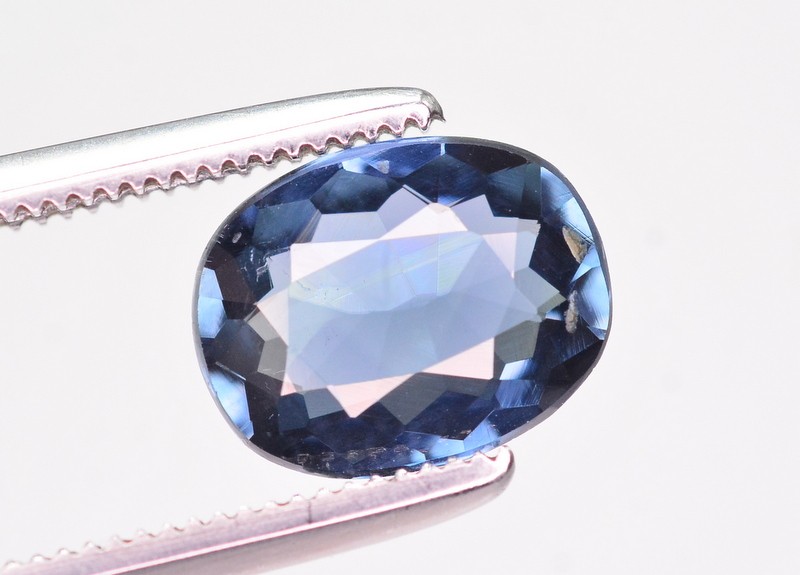
Indicolite Gemstone Properties
Though tourmaline grading is complex, somewhat subjective, and may change with demand, the general categories for indicolite’s value are color, cut, clarity, carat weight, and treatments.
Color
Most indicolite has green undertones, so pure blue indicolite gems are the most valuable. The saturation ranges from grayish to vibrant. Though saturated hues are best, the color has to be light enough to allow you to see the pleochroism, sparkle, and transparency.
Because of that, many darker-colored stones or stones with green undertones are treated to make their color more valuable.
Cut
Faceting indicolite is sometimes a challenge, as the cutter must orient the stone properly to display the pleochroism and dispersion (colorful sparkle) best. This is particularly difficult for dark-colored specimens.
Lighter-colored specimens can have virtually any faceted cut, with emerald, oval, cushion, and fancy shapes being common. Round brilliant or checkerboard shapes are great for highly saturated, larger gem material.
Chatoyant indicolite must be cut en cabochon to display its “cat eye” properly. Otherwise, lower-quality indicolite gem material may be carved, tumbled, or left raw.
Clarity
Indicolite has a Type II colored gemstone clarity grade, meaning high-quality stones usually don’t have visible inclusions to the naked eye but other specimens usually have a few. Among various tourmaline colors, blue and green stones generally have better clarity.
Possible inclusions or impurities in indicolite include:
Color zoning
Long, thin, liquid and gas inclusions
Reflective fractures filled with gas
Most inclusions will lower value, though fibrous bundles of needle-like crystals (often rutile) that cause chatoyancy can produce fairly valuable “cat’s eye tourmaline” indicolite. The value of cat’s eye tourmalines depends on how defined the reflected “cat eye” is, along with the stone’s color, size, and transparency.
Carat Weight & Size
Indicolite comes in a broad range of carat weights, but the price-per-carat ranges are categorized. Gems weighing 0.4 to 2 carats have one range, while gems weighing 2 to 10 carats or more have a higher price range. Cabochons are generally 2 carats or larger.
Overall, there are indicolite gems in sizes for virtually any budget.
Treatments, Synthetics & Simulants
The majority of blue tourmaline available on the market today has been treated with heat and/or irradiation, often labeled with monikers like “blue ice.”
Heat and irradiation lighten indicolite’s color, allowing for better transparency and brilliance. Paraiba tourmalines are often heated to appear neon. These new colors are stable in tourmaline.
Other durability-related treatments are fracture filling (often done with resin or oil) to improve the gem’s clarity and hide imperfections. This is more common in heavily-included stones.
Not all sellers disclose treatments, but there are a couple of clues to look for. If you have multiple indicolites that all look identical, it’s likely they’re treated — untreated gems each look slightly different. Secondly, a color shift as you turn the stone under direct light will usually indicate an untreated indicolite.
Though synthetic tourmaline isn’t common on the jewelry market, different stones may be dyed or otherwise treated and sold as simulants. Some examples are verdelite (another tourmaline variety), spinel, and quartz.

Indicolite Formation & Sources
Tourmalines grow underground. Magma heats groundwater, causing minerals to dissolve. Water carries these dissolved minerals into rock crevices, which then evaporates and the crystal forms.
If the type or amount of trace elements changes during the formation, color zoning can occur.
Elbaite tourmalines like indicolite form in metamorphic and igneous rocks like granite pegmatites and schists, along with hydrothermal deposits.
Mining Locations
Where does indicolite tourmaline come from? Though many locales produce indicolite, the best material for gems comes from Brazil and Sri Lanka.
Additional sources for gem-quality indicolite are:
Afghanistan
Madagascar
Mexico
Mozambique
Namibia
Nigeria
Pakistan
Russia
USA (California & Maine)
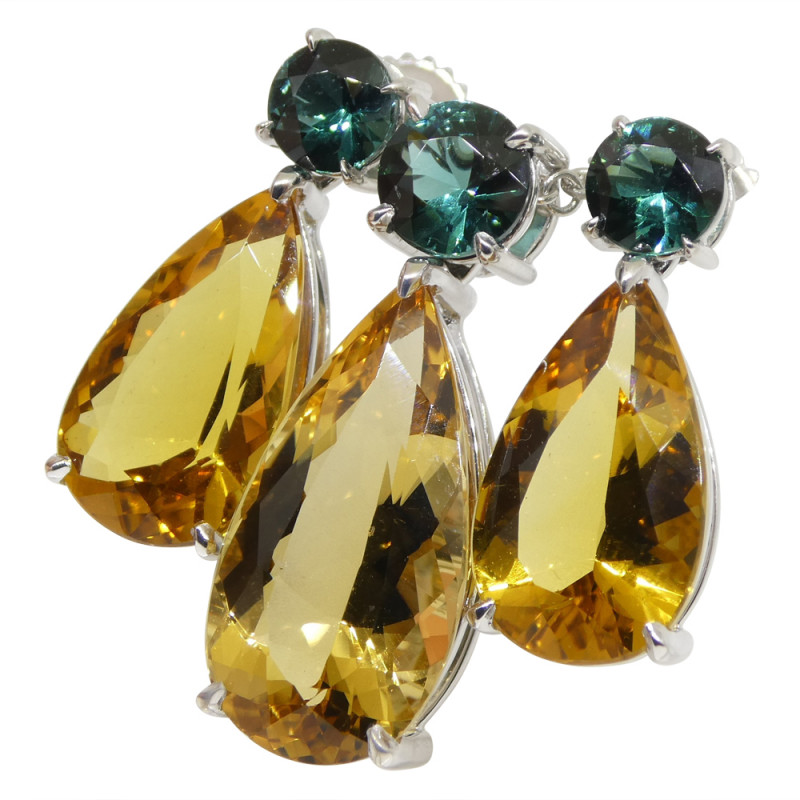 Pictured above: Indicolite and heliodor gemstone jewelry
Pictured above: Indicolite and heliodor gemstone jewelry
Indicolite Stone Price & Value
The most valuable indicolites have pure blue coloring, eye-clean clarity, a good cut that displays the optical properties well, and (usually) no treatments.
The indicolite tourmaline price per carat for faceted indicolite weighing 0.4 to 2 carats ranges from $50 to $500 per carat (contrasting the $30,000 per carat price of top-quality Paraiba tourmaline gems).
Faceted gems weighing 2 carats or more fetch $50 to $1,000 per carat. Regular indicolite cabochons go for $100 to $150 per carat. Cat’s eye cabochons range from $30 to $200 per carat.
Raw indicolite crystals range from $4 to $20 per carat at wholesale.
Indicolite Care and Maintenance
Luckily, gemstone care for indicolite is pretty easy. Any jewelry option is suitable for everyday wear, even a more vulnerable indicolite ring or bracelet.
The only special care required is for treated stones. Fracture-filled stones should be kept away from mechanical cleaners (e.g. ultrasonic or steam cleaners) and harsh chemicals.
Clean indicolite with lukewarm water, mild soap, and a soft toothbrush. Rinse it well, then dry it with a soft, microfiber cloth.
Tourmalines are sensitive to extreme heat and sudden temperature changes. Store indicolite in a relatively cool space away from direct sunlight and other gems.

Inspired by Indicolite?
Whether your favorite color is blue, you love tourmaline gems, or you just want a gem that will sparkle like the sea, indicolite is a phenomenal choice. There’s a shade and vibrancy level for any personality, along with broad price ranges for nearly any budget.
Browse our array of indicolite and other tourmaline gemstones today!
Search the Gemstone Encyclopedia
Related Auctions
Related Articles
Originally the Birthstones or gemstones were associated with a zodiac sign or the month of a individuals birth. Find out what your stone is and view the stones we have for sale
8th Feb 2021
There are dozens of quartz and chalcedony gems with various colors and patterns. Learn all about quartz properties and every type of quartz, from amethyst and agate to plasma and phantom quartz!
15th Oct 2020
Hackmanite is a pink to violet sodalite gem known for its unique color-change and luminescence. Learn why hackmanite is special, from its rare qualities to the types of hackmanite jewelry available.
28th Mar 2018
Latest Articles
Yugawaralite is a rare colorless, white, or pinkish zeolite crystal named for its discovery in Yugawara, Japan. Here we uncover the multifaceted history, properties, prices, and uses of yugawaralite.
24th Mar 2025
Simpsonite is a lesser-known mineral known on the gem market for its durability, yellow-orange color, and rarity. Discover all the properties, uses, prices, and history of simpsonite.
3rd Mar 2025
Kurnakovite is a colorless crystal related to inderite and rarely faceted but known among collectors. Explore the mineral traits, history, prices, and more in this kurnakovite guide.
17th Feb 2025
Article Categories
How To's is where you will find helpful articles from gem Rock Auctions on how to cut gemstones, select gemstones and buy gemstones.
9 Articles








